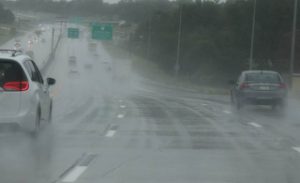New processes and materials make highway paint more visible and longer lasting
March 22nd, 2023 by Ric Hanson
(Ames, Iowa) – When it’s wet, snowy, or icy, it can be tricky to see the painted lines on Iowa roads, potentially making it tough for you to see where you are on the road. Because “Safety First” is one of our core values, our team is constantly working to find better, more durable paint systems that will help you more clearly see paint lines in adverse weather conditions, improving your safety on the road. The focus of the Iowa DOT is the interstate system, U.S. and state highways, so our paint program is geared toward those roads.
The basics of roadway paint
Most roadway paint is a fast-dry variety that is mixed with tiny glass beads to reflect light. When the paint lines are covered with snow, ice, or water, the beads don’t reflect light as well, making the lines more difficult to see. In addition, the beads can wear down as snowplows scrape the lines and traffic drives over them, making them less reflective even in good weather.
Because of this wear and tear, we typically repaint all lane lines and centerlines on U.S. and state highways every year, and the edge lines every other year on a rotating basis. Traditionally, all lines on the interstate were painted every year but we are transitioning to a new paint system that provides increased visibility in wet conditions and enhanced durability and will not need to be repainted every year.
Big changes for interstate paint
Some of the changes to the interstate system paint include:
- A multi-component paint that is more durable than the previously used paint.
- The use of six-inch-wide lines instead of the standard four inches makes the lines more visible to drivers and recognizable to automated vehicle technologies.
- Two types of larger beads are mixed into the new paint.
- “Wet recoverable” beads shed water better
- “Wet reflective” beads use a prism to reflect light even in wet conditions.
- The paint/bead mixture is applied to grooves cut into the pavement surface, making the paint less susceptible to being scraped off by snowplows or worn down by traffic.
- Most interstate lane lines are being painted with alternating black and white paint, improving visibility, especially on lighter-colored pavements and during sunrise/sunset when the low sun angle makes it difficult to see the lane lines.
John Hart, director of our Maintenance Bureau said, “All of these changes have been thoroughly researched and proven to improve visibility, making the roads safer for you. We’ve experimented with different options and are now using what is emerging as a common standard for lane line dashes. If you have driven on roads with these alternating black and white dashes, you’ll see how much they stand out, especially on light-colored pavements.”
New paint changes the way we work, at least on some roads
The chemical composition of the new paint we’re using on the interstate requires different equipment than is currently in the Iowa DOT fleet. Hart explained, “Our current paint trucks aren’t capable of spraying the new paint. Buying new paint trucks isn’t feasible since each truck can cost up to $500,000. So, to get the new paint system applied, we’ll be working with our industry partners instead of painting these lines ourselves. These changes are pretty significant and we’re not going to be able to update the interstate system paint all at once. We’ve been working on this transition for a couple of years and will continue to complete portions over time.”
Cost-to-benefit ratio is positive
Hart said, “Since the new paint is more durable, we will only need to repaint every four or five years, instead of every year. With the reduced paint frequency, the cost-to-benefit ratio of the new paint system is positive for the taxpayers of Iowa.”
Being able to repaint every four or five years instead of every year will be good for more than just the bottom line. Hart said, “Because they travel slowly, our paint trucks are hit by motorists at a pretty high rate. Any time we can provide the same or better service with fewer trucks on the road, that’s a safety benefit for both our operators and you as you’re traveling through Iowa.”
More subtle changes make big impacts on state and U.S. highways
While some of the changes, especially to the interstate system, are being implemented over time, there are other, more subtle updates in place to help you see paint lines better on state and U.S. highways.
Iowa DOT forces are now experimenting with a paint system that uses a better resin that is thicker and more resistant to wear. Hart said, “Even though this is a different paint, our existing trucks are able to apply it. We’re still gathering data, but we expect this new paint to be more reflective for a longer period. We are encouraged by the early results and expect the new paint to last at least two years and possibly three.”
Hart said they are not only monitoring the durability of the new paint systems being used on state and U.S. highways but also working with crews to gauge how easy the new paint is to use. Hart said, “So far our crews love the new paint. It seems to flow through the truck better, with fewer clogs. That makes the operation go much more smoothly and quickly. That ease of use also saves time and money and gets our crews off the road more quickly, improving safety.”





